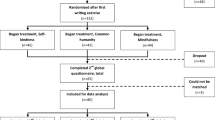Abstract
Hoarding of possessions is thought to be influenced by deficits in information processing, emotional attachments, and erroneous beliefs about possessions. This study examined hypothesized beliefs about possessions using an instrument developed for this purpose, the Saving Cognitions Inventory (SCI). Participants were individuals with compulsive hoarding (n = 95), obsessive compulsive disorder without hoarding (n = 21), and community controls (n = 40). An exploratory factor analysis yielded 4 factors similar to those hypothesized, representing emotional attachment, concerns about memory, control over possessions, and responsibility toward possessions. Subscales created based on these factors were internally consistent, and showed known groups, convergent and discriminant validity. Regression analyses indicated that 3 of the 4 subscales (memory, control, and responsibility) significantly predicted hoarding severity after age, moodstate, OCD symptoms and other OCD-related cognitive variables were entered. Interestingly, difficulty with decision-making also proved to be an important predictor of hoarding behavior. Implications for understanding and treating hoarding are discussed and study limitations are noted.
Similar content being viewed by others
References
American Psychiatric Association. (1994). Diagnostic and statistical manual of mental disorders (4th ed.). Washington, DC: Author
Baer, L., Brown-Beasley, M. W., Sorce, J., & Henriques, A. (1993). Computer–assisted telephone administration of a structured interview for obsessive–compulsive disorder. American Journal of Psychiatry, 150, 1737-1738.
Beck, A. T., Epstein, N., Brown, G., & Steer, R. A. (1988). An inventory for measuring clinical anxiety: Psychometric properties. Journal of Consulting and Clinical Psychology, 56, 893-897.
Beck, A. T., Steer, R. A., & Garbin, M. G. (1988). Psychometric properties of the Beck Depression Inventory: Twenty-five years of evaluation. Clinical Psychology Review, 8, 77-100.
Chambless, D. L., Gillis, M. M., Tran, G. Q., & Steketee, G. (1996). Parental bonding reports of clients with obsessive–compulsive disorder and agoraphobia. Clinical Psychology and Psychotherapy, 3, 77-85.
Clark, D. A., & Purdon, C. (1993). New perspectives for a cognitive theory of obsessions. Australian Psychologist, 28, 161-167.
Frost, R. O., & Gross, R. C. (1993). The hoarding of possessions. Behaviour Research and Therapy, 31, 367-381.
Frost, R. O., & Hartl, T. (1996). A cognitive-behavioral model of compulsive hoarding. Behaviour Research and Therapy, 34, 341-350.
Frost, R. O., Hartl, T. L., Christian, R., & Williams, N. (1995). The value of possessions in compulsive hoarding. Behaviour Research and Therapy, 33, 897-902.
Frost, R. O., Kim, H.-J., Morris, C., Bloss, C., Murray-Close, M., & Steketee, G. (1998). Hoarding, compulsive buying and reasons for saving. Behaviour Research and Therapy, 36, 657-664.
Frost, R. O., Krause, M., & Steketee, G. (1996). Hoarding and obsessive compulsive symptoms. Behavior Modification, 20, 116-132.
Frost, R. O., & Shows, D. L. (1993). The nature and measurement of compulsive indecisiveness. Behaviour Research and Therapy, 31, 683-692.
Frost, R. O., Steketee, G., & Grisham, J. (in press). Measurement of compulsive hoarding: Saving Inventory-Revised. Psychological Assessment.
Frost, R. O., Steketee, G., Williams, L., & Warren, R. (2000). Mood, disability, and personality disorder symptoms in hoarding, obsessive compulsive disorder, and control subjects. Behaviour Research and Therapy, 38, 1071-1082.
Furby, L. (1978). Possessions: Toward a theory of their meaning and function throughout the life cycle. In P. B. Bates (Ed.), Life span development and behavior: Vol. 1. New York: Academic Press.
Guidano, V., & Liotti, G. (1983). Cognitive processes and emotional disorders. New York: Guilford.
Hartl, T. L., Frost, R. O., Savage, C. R., Allen, G. J., Deckersbach, T., Steketee, G., et al. (2003). Actual and perceived memory deficits among individuals with hoarding symptoms. Paper submitted for publication.
Hoekstra, R. J., Visser, S., & Emmelkamp, P. M. G. (1989). A social learning formulation of the etiology of obsessive–compulsive disorders. In P. M. G. Emmelkamp, W. T. A. M. Everaerd, F. Draiimant, & M. J. M. van Son (Eds.), Fresh perspectives on anxiety disorders(pp. 115-123). Amsterdam, The Netherlands: Swets and Zeitlinger.
Kyrios, M. (1998). The cognitive and behavioural treatment of obsessive–compulsive personality and other phenomena. In C. Perris & P. McGorry (Eds.), Cognitive therapy of psychiatric and personality disorders(pp. 351-378). Chichester, England: Wiley.
MacDonald, A. A., Antony, M. M., Macleod, C. M., & Richter, M. A. (1997). Memory and confidence in memory judgments among individuals with obsessive–compulsive disorder and non-clinical controls. Behaviour Research and Therapy, 35, 497-505.
Mataix-Cols, D., Rauch, S. L., Manzo, P. A., Jenike, M. A., & Baer, L. (1999). Use of factor-analyzed symptom dimensions to predict outcome with serotonin reuptake inhibitors and placebo in the treatment of obsessive–compulsive disorder. American Journal of Psychiatry, 156, 1409-1416.
Obsessive Compulsive Cognitions Working Group. (1997). Cognitive assessment of obsessive–compulsive disorder. Behavior Research and Therapy, 35, 667-681.
Obsessive Compulsive Cognitions Working Group. (2001). Development and initial validation of the Obsessive Beliefs Questionnaire (OBQ) and the Interpretation of Intrusions Inventory. Behaviour Research and Therapy, 39, 987-1006.
Obsessive Compulsive Cognitions Working Group. (in press). Psychometric validation of the Obsessive Beliefs Questionnaire and the Interpretation of Intrusions Inventory: Part I. Behaviour Research and Therapy.
Rachman, S. (1997). A cognitive theory of obsessions. Behavior Research and Therapy, 35, 793-801.
Reed, G. F. (1985). Obsessional experience and compulsive behavior: A cognitive structural approach. New York: Academic Press.
Sanavio, E. (1988). Obsessions and compulsions: The Padua Inventory. Behaviour Research and Therapy, 26, 169-177.
Steketee, G., Frost, R. O., & Bogart, K. (1996). Yale Brown Obsessive Compulsive Scale: Interview versus self-report. Behavioral Assessment, 34, 675-684.
Sternberger, L. G., & Burns, G. L. (1990). Obsessions and compulsions: Psychometric properties of the Padua Inventory with an American college population. Behaviour Research and Therapy, 28, 341-345.
Warren, L. W., & Ostrom, J. C. (1988). Pack rats: World class savers. Psychology Today, 22, 58-62.
Author information
Authors and Affiliations
Corresponding author
Rights and permissions
About this article
Cite this article
Steketee, G., Frost, R.O. & Kyrios, M. Cognitive Aspects of Compulsive Hoarding. Cognitive Therapy and Research 27, 463–479 (2003). https://doi.org/10.1023/A:1025428631552
Issue Date:
DOI: https://doi.org/10.1023/A:1025428631552




